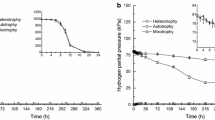Summary
The effects of citrate on diacetyl, acetoin and 2,3-butylene glycol (2,3-BG) production by Leuconostoc mesenteroides subsp. cremoris grown in continuous culture at pH 5.2 were studied. In glucose alone end-product production agreed with the theoretical stoichiometry. In the presence of citrate, lactate and acetate production was higher than the theoretical stoichiometry from glucose. Lactate production was constant when the initial citrate concentration was increased whereas ethanol production strongly decreased. In the absence of citrate, citrate lyase (CL) exhibited weak activity. Diacetyl reductase (DR) and acetoin reductase (AR) exhibited basal activity. When varying citrate concentrations ranging from 10 to 75 mm were added to glucose broth, DR, AR, lactate dehydrogenase, NADH oxidase and alcohol dehydrogenase decreased as the initial citrate concentration increased suggesting that they were partly repressed by citrate. In contrast, CL increased and the specific citrate utilization rate also increased in the same way, indicating no saturation of the first step of citrate metabolism. Acetate kinase (AK) was slightly higher in the presence of citrate and increased when the initial citrate concentration increased. This result was correlated with an increase of acetate from the acetyl phosphate pathway. More ATP was produced in the presence of citrate, which could explain the increase in biomass formation. Citrate bioconversion into diacetyl, acetoin and 2,3-BG increased as the initial citrate increased.
Similar content being viewed by others
References
Anders RF, Hogg DM, Jago GR (1970) Formation of hydrogen peroxide by group N streptococci and its effect on their growth and metabolism. Appl Microbiol 19:602–612
Cogan TM (1987) Co-metabolism of citrate and glucose by Leuconostoc spp: effects on growth, substrates and products. J Appl Microbiol 63:551–558
Cogan TM, O'Dowd M, Mellerick D (1981) Effects of pH and sugar on acetoin production from citrate by Leuconostoc lactis. Appl Environ Microbiol 4:1–8
Cogan TM, Fitzgerald RJ, Doonan S (1984) Acetolactate synthase of Leuconostoc lactis and its regulation of acetoin production. J Dairy Res 51:597–604
De Man JC, Rogosa M, Sharpe ME (1960) A medium for the cultivation of lactobacilli. J Appl Bacteriol 23:130–135
De Moss RD, Bard RC, Gunsalus IC (1951) The mechanism of the heterolactic fermentation: a new route of ethanol formation. J Appl Bacteriol 9:431–441
Fitzgerald RJ, Cogan TM, Doonan S, Mc Kay LL (1990) Intracellular pH and the kinetis of lactic dehydrogenase in Leuconostoc lactis. FEMS 87:D12
Gordon GL, Doelle HW (1974) Molecular aspect for the metabolic regulation of the nicotinamide adenine dinucleotide-dependent d(−)-lactate dehydrogenase from Leuconostoc. Microbios 9:199–215
Gunsalus IC, Gibbs M (1952) The heterolactic fermentation: position of 14C in the products of glucose dissimilation by Leuconostoc mesenteroides. J Biol Chem 194:871–875
Kaneko T, Watanabe Y, Suzuki H (1990) Enhancement of diacetyl production by a diacetyl-resistant mutant of citrate-positive Lactococcus lactis 3022 and by aerobic conditions of growth. J Dairy Res 73:291–298
Lin J, Schmitt P, Diviès C (1991) Characterization of a citrate negative mutant of Leuconostoc mesenteroides subsp. mesenteroides: metabolic and plasmidic properties. Appl Microbiol Biotechnol 34:628–631
Lowry OH, Rosebrough NJ, Farr AG, Randall RJ (1951) Protein measurement with the Folin phenol reagent. J Biol Chem 193:265–275
Mellerick D, Cogan TM (1981) Induction of some enzymes of citrate metabolism in Leuconostoc lactis and other heterofermentative bacteria. J Dairy Res 48:497–502
Nickels C, Leesment H (1964) Method for the differentiation and qualitative determination of starter culture. J Dairy Sci 42:251–263
Schmitt P, Diviès C, R. Cardona (1992) Origin of end-products from the co-metabolism of glucose and citrate by Leuconostoc mesenteroides subsp. cremoris. Appl Microbiol Biotechnol 36:679–683
Seitz EW, Sandine WE, Elliker, Day EA (1963) Studies on diacetyl biosynthesis by Streptococcus diacetylactis. Can J Microbiol 9:431–441
Speckman RA, Collins EB (1968) Diacetyl biosynthesis in Streptococcus diacetilactis and Leuconostoc citrovorum. J. Bacteriol 95:174–180
Author information
Authors and Affiliations
Additional information
Correspondence to: C. Diviès
Rights and permissions
About this article
Cite this article
Schmitt, P., Diviès, C. Effect of varying citrate levels on C4 compound formation and on enzyme levels in Leuconostoc mesenteroides subsp. cremoris grown in continuous culture. Appl Microbiol Biotechnol 37, 426–430 (1992). https://doi.org/10.1007/BF00180962
Received:
Accepted:
Issue Date:
DOI: https://doi.org/10.1007/BF00180962




